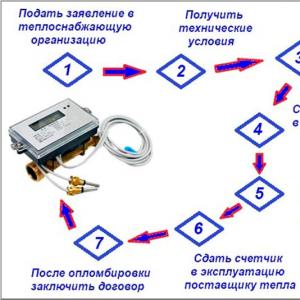How to calculate curtain length. What length and width should the curtains be? Determine the height from the floor. How to choose the size of the curtains for the nursery
Please note that the calculation of the length is done without taking into account the hem of the bottom and top of the curtains, this parameter will be added later. To calculate fabric for curtains, measure with a metal tape measure the distance from the place where the curtain is attached to the eaves to its desired length.
- Length to window sill. In this case, it is recommended to make the curtains slightly higher than the level of the window sill, by about 1 cm. Then they will easily move without touching it.

- Average length. Curtains look good, descending 10-15 centimeters below the window sill line. In addition, this option allows you to reduce.

- Full length. One of the most traditional and favorite options for decorating window openings is floor-length curtains. In this case, you need to measure the distance not to the floor surface, but a little higher. This will protect the fabric from fraying, the curtains can be washed less often, and they will last longer. Curtains falling to the floor certainly look spectacular, but they quickly become unusable and interfere with cleaning.

Width calculation
To calculate fabric for curtains, you need to consider how the fabric will be attached to the cornice, and how lush the curtains will be. The last parameter takes into account the density and width of the folds on the curtain in a fully open state.
Before you start taking measurements, you should hang the cornice - this will be needed to calculate both the length and width of future curtains. Usually the distance from the upper edge of the window to the cornice is in the range from 7.5 to 12.5 centimeters, it must protrude at least 15 cm beyond the width of the window so that it is possible to completely free the window opening from the curtains.
In order to beautifully bend the curtains from the sides when sewing, you need to add 10 centimeters on each side.
How to calculate the fabric for curtains designed, for example, for a standard window opening and a standard ceiling height?
In this case, the length of the cornice can be 2 m, the height of the curtains (to the floor) is 2.6 m. So that they are not too lush, we take the assembly factor equal to 2.


Curtain: tulle
Tulle is made according to the following formulas:
Height: curtain height + bottom hem allowance + top hem allowance
In our case, we have 2.6 + 0.15 + 0.10 = 2.85 (m)
Width: cornice length x assembly factor, or in our case 2 x 2 = 4 (m).
Curtain: curtain
The consumption of fabric for blackout curtains is done according to the same formula, with the only difference being that, unlike tulle, it is made of at least two parts. Therefore, the height will be the same, but the resulting width will have to be divided by two.
Do not throw away the pieces of fabric left after cutting the curtains. From these leftovers, you can sew decorative pillows, ties for curtains, and other decorative elements.
Attention!
If the pattern on the curtains is repeated in length, then when sewing curtains, you will have to adjust the pattern at their junction. To do this, the fabric must be taken with a margin of rapport (a repeating pattern on the fabric). If the rapport is 60 cm long, the fabric should be taken 60 cm more than calculated.
Before you start sewing curtains at home, you need to choose a model for the future product and calculate how much fabric you need.
Measurements that will be required to calculate the consumption of fabric for sewing curtains
- The first (L) is the length of the cornice, which is measured using a centimeter tape or a folding meter;
- The second (H) is, in fact, the length of the future curtain. The value of this measurement depends on the length of the curtain (the curtain can be up to the floor, up to the window sill, ¾ of the height of the wall, etc. - that is, it completely depends on your taste, imagination, and also the style of your room). The size of this measurement is also affected by the type of cornice and the method of processing the top of the curtain. You must immediately determine how you will process the top of the curtain - whether it will be curtain tape, or hinged thread loops, or large fabric loops. By default, this measurement is measured from the top edge of the eaves.
How to calculate fabric consumption for sewing curtains
To find out the width of the curtain, you need to multiply the first measurement (the length of the cornice) by 1.5 - 3.5 and add 10 cm for seam processing. You ask what "1.5 - 3.5" means and how to determine which number to multiply by?
"1.5 - 3.5" is the coefficient of assembly (splendor) of the curtain. The value of the assembly coefficient depends on the density of the fabric and the type of future curtains.
Remember a simple rule:
- if you sew curtains from very thin fabric: organza, organdy, veils, nets, etc. without a pattern - you will need three and a half times the length of the cornice in width,
- for medium-density fabrics: chiffon, tulle, thin fabrics with a pattern - two and a half times more,
- for dense fabrics: velvet, taffeta, linen, gabardine - one and a half to two times.
You can also determine the assembly coefficient of the curtains according to the following table:

To determine the length of the curtain, it is necessary to add 10-15 cm to the second measurement (curtain length) for processing.
So let's sum it up:
Curtain width
- for thin fabrics: L x 3.5 + 10 cm = fabric width;
- for medium density fabrics: L x 2.5 + 10 cm = fabric width;
- for dense fabrics: L x 1.5 + 10 cm = fabric width;
curtain length
- H + 15 cm = fabric length
The width of the roll for most tulle fabrics is 2 meters 80 cm. Knowing this measurement, now it is easy for you to calculate the footage of the fabric to be gathered, provided that the height of the future curtain does not exceed the width of the roll minus the edge.
The width of a roll of curtain fabrics can be different: 1 meter 40 cm, 2 meter 80 cm and 3 meters. If the length of the future curtain fits into the width of the roll, then the fabric consumption is calculated as described above.
If the width of the fabric turns out to be less than the height of the future product (i.e. curtains), then we calculate the fabric consumption differently: we will sew the fabric from several canvases. The number of canvases is directly proportional to the assembly factor and the pattern of the fabric.
For fabrics with a repeating pattern (rapport), it is necessary to take into account additional seam allowances for fitting, i.e., give an additional increase for one pattern repeat on each panel. When stitching the panels, the pattern of the curtains must match exactly.
Welcome to Furniture&Textile. This article provides a small guide to determining the width and length of your curtains. It must be remembered that one of the first and important steps in choosing curtains is to determine the correct and accurate dimensions of future curtains.
To select the size of the curtains, it is first necessary to measure the cornice, window, window sill and measure the distance from them to the walls of the floor and ceiling. For more accurate measurements, use a metal tape measure. It holds its shape well and will allow you to take measurements without distortion.
It is desirable to have a tape measure of at least 5 meters in order not to measure long distances in parts when measuring. Now let's take a closer look.
How to take measurements to choose the size of curtains

To determine the size of the curtains, first of all, it is necessary to determine what you will use and where this cornice will be located. This is important because we will make subsequent measurements from the cornice.
Take a tape measure and measure as shown in the picture. Be sure to record all readings. Take measurements to the nearest centimeter.
- Measure the length of the cornice. (In fact, this will be the width of the window plus the indents on both sides of the borders of the window on which the cornice protrudes.) Measure the length of the cornice, within the limiters - cornice hangers, since the curtain fabric will not go beyond them. If you have a different type of cornice and the curtain can move along its entire length, measure the full size. Let's call this size the Working length of the eaves.
- Measure the distance from the eaves to the floor
- Measure the distance from the eaves to the top edge of the window sill
How to calculate curtain length
The calculation of the length of curtains depends on three main factors:
Choose the type of curtain length you want
To choose the right curtain length, you will need to determine what type of curtains you will use in your room. The following are the main types of curtains, depending on their length.



- Standard long curtains, the size of this type of curtain is equal to the distance from the eaves to the floor minus 1-2 centimeters
- Elongated curtains, the size of this type of curtain is equal to the distance from the eaves to the floor plus 20-30 cm.
- short curtains, the size of this type of curtain is equal to the distance from the eaves to the upper edge of the window sill
Determine the type of fastening of curtains to the eaves
Another element that affects the length of the curtains- this is a type of curtain fastening to the eaves.
- If you use curtain fasteners in the form of loops or hooks, then the length of the curtain should be measured taking into account the height of this fastener. In the version with hinged fasteners, the total length of the curtain fabric must be reduced by the size of the hinges.
- If eyelets are used as fasteners, then the size of the curtain fabric should be reduced by the distance of the eyelets from the top edge of the curtains.


The figure shows the fastening of curtains in the form of loops and in the form of eyelets.
In this way, the total length of the curtain will be equal to the length of the curtain fabric plus minus the length of the curtain fastener.
Consider curtain length allowances
When buying fabric for curtains, do not forget to provide allowances of 5 cm on the upper and lower edges of the curtains for processing and hemming. The upper and lower edges of the curtains must be hemmed, otherwise the fabric of the curtains may unravel and "shaggy".
How to calculate curtain width
The width of the curtain depends on the width of the window and the length of the cornice. But in order to choose the right width of the curtains, you need to decide on the number and volume of assemblies on the curtains. standards that allow you to make the curtains look neat and harmonious.
Choosing the width of the curtain depending on the type of fabric
There is the concept of curtain splendor, which determines the number of folds on the curtain fabric according to its width.
To calculate the total width of the curtain, depending on the type of fabric, the coefficient of splendor (Kp) is used.
To determine the width of the curtains, taking into account the type of fabric, you must:
Multiply the working length of the cornice by the coefficient of splendor.
Splendor coefficient depending on the type of fabric
- For dense heavy fabrics Kp=2
- For fabrics of medium density Kp = 2.5
- For light fabrics of low density Kp=3
In the photo there is a curtain made of dense velveteen Kp = 2

In the photo, a curtain of medium density Kp \u003d 2.5

The photo shows examples of light curtains Kp = 3
Selection of the width of the curtains depending on the number of folds
Here are some tips for choosing the width of the curtains and choosing the number of folds on the curtains.
- When choosing a drapery, consider the volume of the room in which the curtains will be used.
- Very lush curtains will look intrusive in a small room.
- You should not make many folds on curtains with a pronounced pattern.
- Consider the style of the interior. Do not use lush curtains in minimalist and high-tech interiors

In the photo above and below are examples of curtains with a pronounced pattern
To determine the width of sliding curtains, you can use the following table
| Cornice length | Curtain width |
| Cornice no more than 1.4 m. | The width of the panel is equal to the length of the cornice |
| Eaves no more than 2.0 m. | The width of the panel is 1.5 times the length of the cornice |
| Cornice no more than 2.8 m. | The width of the panel is equal to 2 lengths of the cornice |
| Cornice no more than 3.4 m. | |
| Eaves no more than 4.0 m. | The width of the panel is equal to 2.5 lengths of the cornice |
Using the table, you will get the required total width of the curtains. Keep in mind that the total width assumes the width of all canvases- after all, curtains can also consist of several curtains.
In the case when you do not want folds on the fabric of the curtains at all, then the width of the curtains will be equal to the length of the cornice.
Curtain Width Allowances
As a rule, curtain fabrics already have edge processing on the sides. But if you are using a different type of fabric, then do not forget about an additional 5 centimeters from each edge of the curtain for processing and hemming.
Choosing the length and width of curtains depending on the type of room
Choosing the size of curtains for the kitchen

The length and width of the curtains in the kitchen. Since there are many sources of pollution in the kitchen - grease, steam and other delights, for easier care of the curtains, it is preferable to have curtains with a small area of contamination. Under this criterion, curtains up to the window sill and with a minimum number of folds in width are suitable., Optimally - smooth, read in width equal to the length of the eaves. Of course, if you are not afraid of more frequent washing of curtains, then you can choose long and more draped options.

- Curtains in the living room in length.Classic floor-length curtains will look good in the living room. That is, the length of the curtains is equal to the distance from the cornice to the floor, plus or minus the fastening of the curtains.
- Curtains in the living room in width. The width depends on the size of the room and the style of the interior. If the living room is in classic styles, then the drapery of the curtains is also acceptable, which means that the width of the curtains can be calculated from the table above. If the interior is in a modern style, for example, an interior in a minimalist style, then the width of the curtains should be equal to the length of the cornice - that is, smooth and without folds.
How to choose the size of the curtains for the bedroom

Curtains in the bedroom are preferable with a voluminous and immersing texture.
- Bedroom Curtain Length. Elongated curtains with a length of 20-30 centimeters more than the distance from the eaves to the floor are well suited.
- The width of the curtains in the bedroom should provide maximum folds i.e. not less than 2.5 lengths of the eaves.
How to choose the size of the curtains for the nursery

Curtains in the nursery should be easy to wash and not have extra areas for pollution. Active kids play everywhere, including near windows.
- The length of the curtains for the nursery. The optimal length will be to the floor without unnecessary laps. That is, the distance from the eaves to the floor.
- The width of the curtains in the nursery it can be like in the living room without unnecessary folds, but more draped options can be made, i.e. curtain width from 1.5 to 2.5 lengths of the cornice.
Video how to choose the size of curtains
Finally, to consolidate the material, you can watch a video with a step-by-step plan for determining the size of curtains
Welcome to Furniture&Textile. This article provides a small guide to determining the width and length of your curtains. It must be remembered that one of the first and important steps in choosing curtains is to determine the correct and accurate dimensions of future curtains.
To select the size of the curtains, it is first necessary to measure the cornice, window, window sill and measure the distance from them to the walls of the floor and ceiling. For more accurate measurements, use a metal tape measure. It holds its shape well and will allow you to take measurements without distortion.
It is desirable to have a tape measure of at least 5 meters in order not to measure long distances in parts when measuring. Now let's take a closer look.
How to take measurements to choose the size of curtains

To determine the size of the curtains, first of all, it is necessary to determine what you will use and where this cornice will be located. This is important because we will make subsequent measurements from the cornice.
Take a tape measure and measure as shown in the picture. Be sure to record all readings. Take measurements to the nearest centimeter.
- Measure the length of the cornice. (In fact, this will be the width of the window plus the indents on both sides of the borders of the window on which the cornice protrudes.) Measure the length of the cornice, within the limiters - cornice hangers, since the curtain fabric will not go beyond them. If you have a different type of cornice and the curtain can move along its entire length, measure the full size. Let's call this size the Working length of the eaves.
- Measure the distance from the eaves to the floor
- Measure the distance from the eaves to the top edge of the window sill
How to calculate curtain length
The calculation of the length of curtains depends on three main factors:
Choose the type of curtain length you want
To choose the right curtain length, you will need to determine what type of curtains you will use in your room. The following are the main types of curtains, depending on their length.



- Standard long curtains, the size of this type of curtain is equal to the distance from the eaves to the floor minus 1-2 centimeters
- Elongated curtains, the size of this type of curtain is equal to the distance from the eaves to the floor plus 20-30 cm.
- short curtains, the size of this type of curtain is equal to the distance from the eaves to the upper edge of the window sill
Determine the type of fastening of curtains to the eaves
Another element that affects the length of the curtains- this is a type of curtain fastening to the eaves.
- If you use curtain fasteners in the form of loops or hooks, then the length of the curtain should be measured taking into account the height of this fastener. In the version with hinged fasteners, the total length of the curtain fabric must be reduced by the size of the hinges.
- If eyelets are used as fasteners, then the size of the curtain fabric should be reduced by the distance of the eyelets from the top edge of the curtains.


The figure shows the fastening of curtains in the form of loops and in the form of eyelets.
In this way, the total length of the curtain will be equal to the length of the curtain fabric plus minus the length of the curtain fastener.
Consider curtain length allowances
When buying fabric for curtains, do not forget to provide allowances of 5 cm on the upper and lower edges of the curtains for processing and hemming. The upper and lower edges of the curtains must be hemmed, otherwise the fabric of the curtains may unravel and "shaggy".
How to calculate curtain width
The width of the curtain depends on the width of the window and the length of the cornice. But in order to choose the right width of the curtains, you need to decide on the number and volume of assemblies on the curtains. standards that allow you to make the curtains look neat and harmonious.
Choosing the width of the curtain depending on the type of fabric
There is the concept of curtain splendor, which determines the number of folds on the curtain fabric according to its width.
To calculate the total width of the curtain, depending on the type of fabric, the coefficient of splendor (Kp) is used.
To determine the width of the curtains, taking into account the type of fabric, you must:
Multiply the working length of the cornice by the coefficient of splendor.
Splendor coefficient depending on the type of fabric
- For dense heavy fabrics Kp=2
- For fabrics of medium density Kp = 2.5
- For light fabrics of low density Kp=3
In the photo there is a curtain made of dense velveteen Kp = 2

In the photo, a curtain of medium density Kp \u003d 2.5

The photo shows examples of light curtains Kp = 3
Selection of the width of the curtains depending on the number of folds
Here are some tips for choosing the width of the curtains and choosing the number of folds on the curtains.
- When choosing a drapery, consider the volume of the room in which the curtains will be used.
- Very lush curtains will look intrusive in a small room.
- You should not make many folds on curtains with a pronounced pattern.
- Consider the style of the interior. Do not use lush curtains in minimalist and high-tech interiors

In the photo above and below are examples of curtains with a pronounced pattern
To determine the width of sliding curtains, you can use the following table
| Cornice length | Curtain width |
| Cornice no more than 1.4 m. | The width of the panel is equal to the length of the cornice |
| Eaves no more than 2.0 m. | The width of the panel is 1.5 times the length of the cornice |
| Cornice no more than 2.8 m. | The width of the panel is equal to 2 lengths of the cornice |
| Cornice no more than 3.4 m. | |
| Eaves no more than 4.0 m. | The width of the panel is equal to 2.5 lengths of the cornice |
Using the table, you will get the required total width of the curtains. Keep in mind that the total width assumes the width of all canvases- after all, curtains can also consist of several curtains.
In the case when you do not want folds on the fabric of the curtains at all, then the width of the curtains will be equal to the length of the cornice.
Curtain Width Allowances
As a rule, curtain fabrics already have edge processing on the sides. But if you are using a different type of fabric, then do not forget about an additional 5 centimeters from each edge of the curtain for processing and hemming.
Choosing the length and width of curtains depending on the type of room
Choosing the size of curtains for the kitchen

The length and width of the curtains in the kitchen. Since there are many sources of pollution in the kitchen - grease, steam and other delights, for easier care of the curtains, it is preferable to have curtains with a small area of contamination. Under this criterion, curtains up to the window sill and with a minimum number of folds in width are suitable., Optimally - smooth, read in width equal to the length of the eaves. Of course, if you are not afraid of more frequent washing of curtains, then you can choose long and more draped options.

- Curtains in the living room in length.Classic floor-length curtains will look good in the living room. That is, the length of the curtains is equal to the distance from the cornice to the floor, plus or minus the fastening of the curtains.
- Curtains in the living room in width. The width depends on the size of the room and the style of the interior. If the living room is in classic styles, then the drapery of the curtains is also acceptable, which means that the width of the curtains can be calculated from the table above. If the interior is in a modern style, for example, an interior in a minimalist style, then the width of the curtains should be equal to the length of the cornice - that is, smooth and without folds.
How to choose the size of the curtains for the bedroom

Curtains in the bedroom are preferable with a voluminous and immersing texture.
- Bedroom Curtain Length. Elongated curtains with a length of 20-30 centimeters more than the distance from the eaves to the floor are well suited.
- The width of the curtains in the bedroom should provide maximum folds i.e. not less than 2.5 lengths of the eaves.
How to choose the size of the curtains for the nursery

Curtains in the nursery should be easy to wash and not have extra areas for pollution. Active kids play everywhere, including near windows.
- The length of the curtains for the nursery. The optimal length will be to the floor without unnecessary laps. That is, the distance from the eaves to the floor.
- The width of the curtains in the nursery it can be like in the living room without unnecessary folds, but more draped options can be made, i.e. curtain width from 1.5 to 2.5 lengths of the cornice.
Video how to choose the size of curtains
Finally, to consolidate the material, you can watch a video with a step-by-step plan for determining the size of curtains
But also with the size of the cloth, which is sometimes much more difficult. Properly sized curtains can emphasize all the advantages of the room, while too wide, long or short can spoil even the most ideal and stylish room. Therefore, before going to the store for curtains or when buying fabric for them, you need to clearly know what size curtains you need.
We take measurements
Naturally, the process of determining the optimal size of curtains begins with the necessary measurements. So, the main data that we need to get is the width and length of future curtains, and all other data, assembly type, etc., are then calculated based on this data.
It should be noted that it is worth taking measurements already after the cornice has been selected and installed. , can be attached to a wall or ceiling, but in any case, the length of the cornice must exceed the width of the window. If there is another room for relaxation, then you can mount the cornice in general on the entire width of the walls, effectively emphasizing the window area. In other rooms, the cornice should be 20-30 cm larger than the window opening so that the curtains can move, making way for the sun's rays, the exception is where, as a rule, only translucent hangs, and the length of the cornice is almost the same as the width of the window. Please note that there are now curtain rods with adjustable length: if desired and necessary, they can be made a little shorter or longer.
Preferably, of course before taking measurements, already decide on the model of curtains, since the calculation of the length and width of the required fabric will depend on the type of fabric, fastening, number of layers of window decoration.
- curtain width can be measured tape measure or soft measuring tape from the first attachment to the last.
- Curtain length is measured from the cornice or from selected fasteners, such as rings, to the mark you need.
Determine the width of the curtain
 So, we measured the distance from the left hook to the right, but the resulting figure does not mean the desired width of the curtain, because in this case it will only hang with a free canvas. In the vast majority of cases, you need drapery, but how lush and voluminous it will be depends on the nuances of a separate room.
So, we measured the distance from the left hook to the right, but the resulting figure does not mean the desired width of the curtain, because in this case it will only hang with a free canvas. In the vast majority of cases, you need drapery, but how lush and voluminous it will be depends on the nuances of a separate room.
It is worth noting in advance that you need to be especially careful with drapery:

Remember that this rule works regardless of how many panels are used to decorate the window - one or two. But in the latter case, another 15 cm is added to the calculated length of the curtains, so that the canvases can overlap each other when closed, creating a spectacular blackout.
Long-term experience of masters in tailoring curtains gave grounds to develop exemplary fabric width values depending on the length of the cornice. You can use the rule described above, or you can take into account the following data:

As a rule, the size of the room and windows are proportional, so these simple tips and calculations will help you determine the right width of the curtains without any problems to make the room look neat and comfortable.
Please note that sometimes the width of the curtains depends on the selected models. So, for example, abundant draperies are appropriate for translucent curtains, but there should be folds on massive dense curtains, but they may already be less voluminous, so you should rely on your own taste, or use proven data on the assembly coefficient for each type of fabric.
So, for curtain fabric this coefficient is 1.7, for a veil and organza with a pattern - 2, and for a thin organza without a pattern - 3.

Width and length of Roman blinds
Lambrequin width corresponds to the length of the cornice, so if you decide to decorate the window with a similar element, then it will be unnecessary to use any correction factors and carry out additional calculations.
Width of Roman, roller, Japanese blinds
Separately, it is worth mentioning such types of curtains as roman, roller blinds, japanese blinds and other similar structures. Roller blinds and Roman blinds are usually placed directly in the window opening, so their width corresponds to the width of the window, measured from glazing bead to glazing bead. Sometimes roller blinds are placed on the wall above the window, then their width should be 10-15 cm larger than the window opening, completely covering the window and slightly going beyond the borders in order to hide the residents from the rays of light as much as possible.
Width they choose exactly according to the width of the window opening, and Japanese curtains, consisting of many panels, can go far beyond the window, or can cover only the transparent part without going beyond its borders. It all depends on the design decision and the features of the room, its area, etc.
Determine the length of the curtain
 The length of curtains is even more important than their width. Here it is necessary not only to measure everything correctly, but also to imagine in advance, what length of curtains would be more appropriate. The choice depends on the functional purpose of the room, as well as on its features: area, height, illumination, etc. If this is the case, then long curtains may be inappropriate, with the exception of a translucent tulle with a vertical stripe. in the kitchens in most cases, long curtains are also not suitable: they will interfere and clutter up the already mostly cramped rooms. But if the kitchen is spacious, and there is a lot of free space near the window, there is no stove or sink, there is a dining area, then you can experiment with floor-length curtains. Rooms such as bedroom and living room, require the use of long curtains that will cover the entire window opening and fall to the floor.
The length of curtains is even more important than their width. Here it is necessary not only to measure everything correctly, but also to imagine in advance, what length of curtains would be more appropriate. The choice depends on the functional purpose of the room, as well as on its features: area, height, illumination, etc. If this is the case, then long curtains may be inappropriate, with the exception of a translucent tulle with a vertical stripe. in the kitchens in most cases, long curtains are also not suitable: they will interfere and clutter up the already mostly cramped rooms. But if the kitchen is spacious, and there is a lot of free space near the window, there is no stove or sink, there is a dining area, then you can experiment with floor-length curtains. Rooms such as bedroom and living room, require the use of long curtains that will cover the entire window opening and fall to the floor.
So, when you have decided on where the curtains will end, it's time to take measurements. Measure length from the eaves to the floor or to, or to any desired point. Please note that you need to think over the system for attaching curtains in advance, and if these are hooks or rings, then you will need to measure the length of the curtains from them, and not from the eaves.
 In and bedrooms many experts recommend choosing the length of the curtains in such a way that there is still 3-4 cm left to the floor - for reasons of comfort and convenience. If the decoration of the window will consist from several layers, then curtains should be several centimeters longer than curtains to completely cover their edge.
In and bedrooms many experts recommend choosing the length of the curtains in such a way that there is still 3-4 cm left to the floor - for reasons of comfort and convenience. If the decoration of the window will consist from several layers, then curtains should be several centimeters longer than curtains to completely cover their edge.
Many apartments cannot boast of a flat floor or ceiling, in which case it is better to carry out curtain length measurements left, right and middle, and then use either the average or the maximum value, depending on the deviation present.
Even if you plan to choose for a room curtains to the floor, it is better to follow the practice of professional seamstresses and measure distance from the eaves to the window sill and from the window sill to the floor. When you come to the store and start choosing a certain model, there is a high degree of probability that you will like cascading curtains, with tiebacks or other elements. In this case, you will definitely know all the parameters of your window opening.
Pelmet length can be anything: it all depends on your preferences and the interior features of the room.
 If you buy fabric for sewing curtains, then you need to add 5 cm to the data obtained in terms of length and width, which will be spent on bending and processing.
If you buy fabric for sewing curtains, then you need to add 5 cm to the data obtained in terms of length and width, which will be spent on bending and processing.
There is models of curtains that effectively fall on the floor: if you want to hang the same ones at home, then add another 20-50 cm to the measured length to form a spectacular wave.
If you want to sew curtains with your own hands and choose patterned fabric, and curtains, for example, will consist of two parts, then you need to correctly combine the pattern. If the ornament is repetitive, then you need to measure that part of it that is constantly duplicated. For example, it will be 70 cm, and add the result to the final value of the fabric length.
Another important point: now widespread artificial fabrics, which are very durable in operation and almost do not shrink when washed, so if you want to sew curtains from them, you should not do any additional shrinkage allowances. If the fabric is in stock over 60% natural fibers, then the probability that it will shrink a little after washing increases, therefore fabric in this case is taken with a margin- by about 10%. If you want the window to be decorated with original and unique curtains that are not available in the store, then you need to buy the required amount of fabric for their tailoring. So, how much fabric will be needed for curtains and curtains for our conditional window?
The standard width of a roll of translucent tulle is 2.8 m, which should be enough for the standard window height, so the length issue remains resolved. As for the width, with a given window width and a selected CC, fabric 2 * 2 = 4 m will be required. But since it leaves 5 cm for allowances on the sides, the total amount of fabric will be 4.1 m.
curtain fabric width, as a rule, is 1.4, 2.8 or 3.0 meters. It is good if the width of the canvas is ideal for the length of the window opening, but it may be that the width is not enough, and then you have to measure the fabric along and use several canvases to cover the window opening. Here it is important not to forget about the combination of the pattern and the length of the rapport - a repeating element of the ornament. In this case, you can sew between a special piece of fabric, or maybe just make curtains in two parts.
The calculation in this case would be:
amount of fabric \u003d ((window opening height + allowance) * number of paintings) + rapport * (number of paintings - 1)
 If the width of the window is 2 m and KS = 2, and the width of the fabric in the roll is 1.4 m, then for the manufacture of curtains, for example, you will need 3 canvases: 1.4 * 3 = 4.2 m, with a rapport value of 0.35 m we get the following data:
If the width of the window is 2 m and KS = 2, and the width of the fabric in the roll is 1.4 m, then for the manufacture of curtains, for example, you will need 3 canvases: 1.4 * 3 = 4.2 m, with a rapport value of 0.35 m we get the following data:
amount of fabric \u003d ((2.7 + 0.2) * 3) + 0.35 * 2 \u003d 9.4 m
If after cutting the fabric and sewing the curtains there will be stay a lot of tissue, and this may be when a large pattern was chosen, then from the remnants it will be possible to sew tiebacks for curtains or small pillows on the sofa. When the curtains and some other textiles in the room are made in the same style, this gives a special effect to the room.
The most common models of curtains are easy to sew on your own, but if you doubt your professionalism or plan to decorate the window with an elaborate model, then it is better to resort to the services of specialists.
In conclusion
The length and width of curtains are important parameters of window decoration, which should be given no less importance than fabric, pattern and color. The right size will decorate the room and make it more comfortable, so before you go to the store for ready-made curtains or fabric for them, you need to take all the necessary measurements from the window opening, write them down and start from them when choosing.









